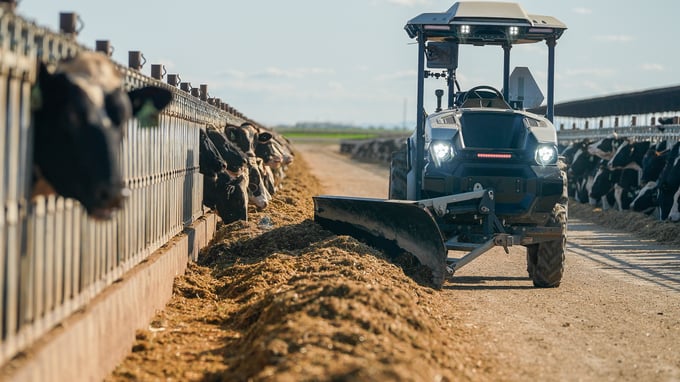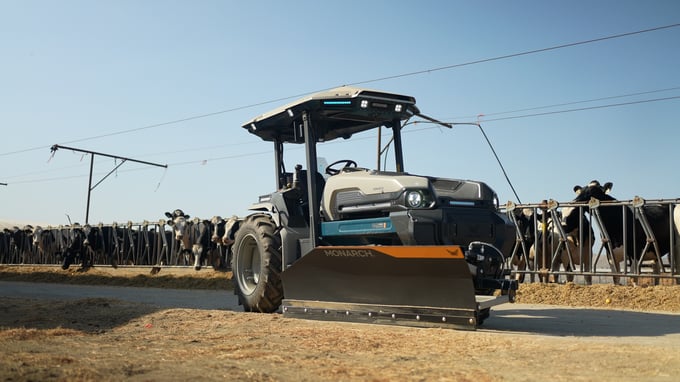Dairy farmers rely on tractors to perform critical operations and that typically means pushing feed. Most dairy cows in the U.S. spend at least some of their time indoors and depend on farmers to provide them with ample, nutritious food to keep them healthy, thriving, and producing lots of milk. Dairy farmers with indoor feeding lanes are finding out that Monarch’s MK-V Dairy is doing much more than feeding cows.
Feeding the Bottom Line
Indoor dairy farmers are tasked with keeping their cows full of their special-blended feed. In their eagerness to eat, cows push their food down and out into the aisle where they eventually can’t reach it. As often as 12-18 times per day, a dairy farmer must push the food back up. This task is one of the more important roles of a tractor on a dairy farm. The more a cow can access her food, the more milk she will produce. However, tractors cost money to operate in the form of diesel fuel.
.png?width=800&name=MT_Feb24_DairyBlade-82%20(1).png)
I’ve worked on dairy farms in the U.S. for the past 26 years. I think to survive, every dairy farm must get better at everything that they do. To become more efficient, we have to reduce costs and we have to increase production.
Dr. Abraham Du Plessis, Dairy Consultant & Veterinarian, Progressive Dairy Solutions
As an electric tractor, the MK-V solves a dairy farmer’s conundrum. From the first time the MK-V Dairy is put into service pushing feed, a farmer realizes instant savings in fuel. Electric tractors also have lower maintenance demands and costs, which also contribute to long-term farm profitability.
Healthy Living Environment
Spending some time indoors offers protection from predators, parasites, and extreme weather exposure, which can support the overall health and wellness of cows and their calves. For all their benefits, a sheltered or indoor dairy farm increases exposure to two potentially harmful elements: toxic air emissions and noise.
In an indoor dairy environment, diesel tractor fumes are more likely to take longer to dissipate or be ventilated. Countless studies link exposure to diesel exhaust to numerous serious respiratory and heart health conditions, along with irritation, nausea, and headaches. Because an MK-V runs on electric power, there are zero smelly, toxic fumes being inhaled by tractor operators or cows. Then there’s the issue of indoor noise hygiene. Quieter operations support the health and well-being of livestock and workers.
Advanced Ag Technology
The MK-V Dairy armed with the MK-V Feed Pusher is more than an electric tractor and implement, it’s an advancement of AgTech in the dairy industry. Simple controls let operators manage tractor speed and implement height quickly and easily. The push blade can also be used in a float mode to follow the ground’s natural contours and extend the life of the blade.
This data-driven tractor features 360-degree cameras and bright work lights. Through the Wingspan Ag Intelligence (WingspanAI) app, farmers can see operators pushing feed to the cows day or night. The MK-V’s AgTech collects and reports data on when and where feeding occurs, giving a dairy farmer insights to make data-driven decisions to optimize feeding schedules.
The MK-V Dairy is also equipped with driver-optional capabilities. Monarch’s Autodrive Feed Pushing is coming to outdoor dairies in the second half of 2024. When the capability is eventually released to indoor dairies, the MK-V will be ready for action.
Dairy Farmer-First
Dairy farmers work hard to produce an important food staple that helps take care of the nutritional needs of millions of people. Now dairy farmers have a smart, EV tractor that helps take care of them. The MK-V is engineered to increase dairy farm profitability while allowing dairy farmers to manage their farms in a way that’s healthier for their cows and the environment, indoors or out.
References:
Dimov D, Penev T, Marinov I. Importance of Noise Hygiene in Dairy Cattle Farming—A Review. Acoustics. 2023; 5(4):1036-1045. https://doi.org/10.3390/acoustics5040059




